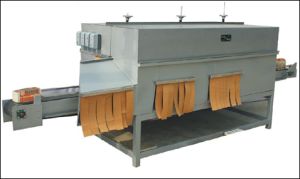
TRIPLE STAGE CUTTING conveyor machine
This machine has a automatic conveyor. Battery is placed on the conveyor. Width of Battery, need not to be set. It can accommodate Battery up to Max. Width of 305mm. Most of Batteries are less than this. This machine has three Blades for Cutting. Cutting heights of all the three blades can be set at independent heights by turning Rotary wheel. This wheel is visible in picture of machine. Scale is provided to set the height of cutting from bottom. Conveyor takes the Battery into machine for cutting. First Cutting is set above lid so any battery which has more height than normal automotive batteries like Standby Batteries i.e. IT-500, Jumbo etc. will be cut and that portion ejects out from first window. Second cutting is set normally at sealing line of automotive battery lid and third cutting is set below strap.During Cutting of Battery dust is confined inside of covers because cutter is enclosed. Max. Of Automotive Batteries have approximately same height, say +-10 mm. Cut Lid ejected out of first window and Strap portion of battery ejects out form second window. Remaining Battery will come out of machine on Conveyor. Machine can be provided with wheels so machine is used to unload battery at the same time cutting is performed.This saves exposure of workman from Lead Dust; increases efficiency of organization reduces lead time as well as increases liquidity of Funds. Plastic Containers can be sent for immediate disposal/recycling facility. Lead Dust is confined inside enclosure at the same time water jets are provided by pre-fitted Pump. Water is collected in the bottom tank. This helps to separate Plastic Dust from Lead dust. Plastic dust floats and lead dust is precipitated at the bottom. Hence it becomes environmentally Sound Method to cut the Battery for further separation. Remember this Cut Battery can directly go to another attachment; we call it Acid Draining Attachment. Details of this attachment are mentioned below. This machine is suitable for normal quantity of Batteries or by small smelter with normal budget. Power required: 415V 3 phase, 12 Kw approx. Belt made of : Nylon
...more
mini blast furnace
A Mini Blast Furnace (commonly known as MandirBhatti or ShahiBhatti) is a simple, time-tested and widely used system to produce secondary lead in India and many other countries. It is the most basic of all furnaces and a production system basedon this technology has certain distinct characteristics such as: Low Project Capital Cost Low Energy Cost (wooden coke fired) Easy to install Easy to operate & maintain Production of low Antimony Lead (soft lead) at low temperature Generates high pollution
...more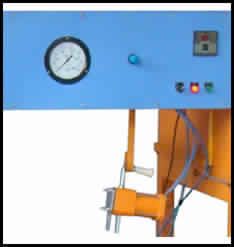
stress testing machine
Application :- This will check strength of welded connections torsion strength by applying mechanical force across connections. Operation :- Fingers has to put manually across connection so it is able to apply Force on one connection against other this force can be varied depending on connection size or size of battery, if that connection is hollow it will break. The time to apply force is determined by Digital Timer so force as well time to apply force is precisely preset hence result become accurate.
...more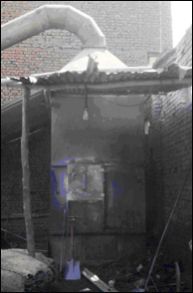
SINGLE TEMPLE FURNACE
The Furnace itself is a modified blast furnace which consists of a brick lined structure with fire brick oven in the midst and ametal Exo-skeletal structure outside. Raw material & fuel (coke) is charged manually through the side metal doors fitted in the brick structure and air is provided from the FD fans provided at the back of the brick structure. Molten metal & slag is tapped at the pits made in front of the brick structure and flue gases are sucked from the top of the brick structure which is provided with a metallic hood.
...more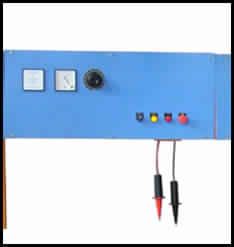
SHORT CIRCUIT TESTER
Application :- This machine checks pin hole, separator missing and splash of lead in cells, etc. It also checks that all the cells are connected to each other with the help of high voltage. If there is any fault then it gives visual indication as well as audio alarm.Operation :- Operator has to place the Battery underneath the machine and press the button on its Probe, which initiates machine that does its job for One cell in one go.
...more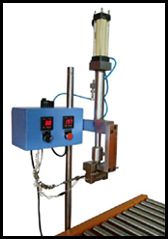
SERIAL NO. PUNCHING MACHINE
Operator need not to change punches daily. Operator has to press a push button, which initiates pneumatic cylinder for a set period so hot punches are pressed at set temp. For the set period with a set force to mark the exact depth on battery cover. This machine is more accurate. Every Battery manufactured will have distinguished Mark on it. It can be alphabetically or numerically or Combination of both. Number of Punches can be Six/Eight/Ten or as per requirement of individual Manufacturer.
...more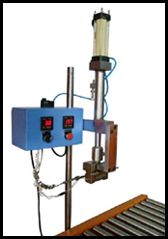
SERIAL NO PUNCHING MACHINE
Operator need not to change punches daily. Operator has to press a push button, which initiates pneumatic cylinder for a set period so hot punches are pressed at set temp. For the set period with a set force to mark the exact depth on battery cover. This machine is more accurate. Every Battery manufactured will have distinguished Mark on it. It can be alphabetically or numerically or Combination of both. Number of Punches can be Six/Eight/Ten or as per requirement of individual Manufacturer.
...more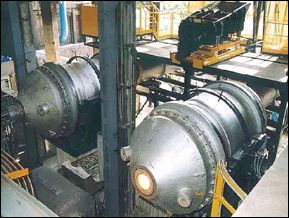
Rotary Furnace
Lead to be manufactured from Rotary Furnace can be obtained directly from scrapped batteries or as slag from Mini Blast Furnaces In case of former batteries are cut open or broken to segregate lead scrap, plastic and other materials from them;lead scrap in the form of lead powder/ plates etc. is charged in the furnace along with a proportionate charge of additives. InThe case of latter, slag produced from Mini Blast Furnaces is charged into the Rotary Furnace, again with proportionate additives.This process is a batch type process. After filling the required quantity of raw material (either manually or mechanically), thelid of the furnace at the front is closed. The burner attached to the moving door is then fired. The Rotary Melting Furnace is very flexible and universal equipment used for recycling many non-ferrous metals. It is themajor lead production technology used in India and many other countries for Secondary Lead Production. A lead production system based on this technology has certain distinct characteristics such as: Equipment scalable for installing higher capacities Recovers all lead in one production cycle Plates & powder from scrap battery as well as slag from Mini Blast Furnace can be used as raw material Requires addition of certain consumables Can be fired with various fuels Generates high Pollution both as Flue Gases & Fugitive Emissions Apart from plates and paste of lead oxide from scrap batteries, slag from Mini Blast Furnace is charged in the Rotary Furnace.In addition to these, certain compounds of sulphur are also present in the batteries. When this material is heated in thePresence of carbon, lead oxide is converted to lead. This conversion along with burning of fuel generates flue gases and fumescontaining dust, dirt, oxides of lead, lead particles and such other impurities etc.Hence, to meet various goals of maintaining employees' health and factory environments as well as regulatory requirements,it becomes imperative to get high end Air Pollution Control Systems to be installed with the Rotary Furnaces.
...more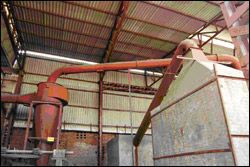
Rotary Chamber Machines
Recovers 100% lead in the first operation. Slag produced is lead free. Equipment can be scaled up for higher production capacities. Many chemicals are required for operation. High power consumption.
...more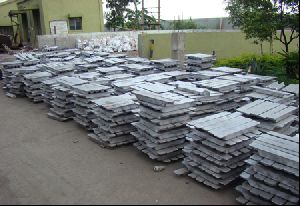
Pure Lead
Pure Lead Ingot is being produced from Raw Lead Bullion / Remelted and Secondary Lead Ingots / Lead Scraps though Pyro-metallurgical process. Refining Process, producing Pure Lead Ingots with a minimum purity level of 99.97% by weight but achieves purity level of 99.985% in most of cases.
...more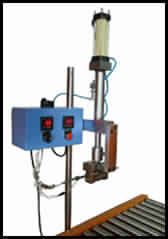
Punching Machine
Operator need not to change punches daily. Operator has to press a push button, which initiates pneumatic cylinder for a set period so hot punches are pressed at set temp. For the set period with a set force to mark the exact depth on battery cover. This machine is more accurate. Every Battery manufactured will have distinguished Mark on it. It can be alphabetically or numerically or Combination of both. Number of Punches can be Six/Eight/Ten or as per requirement of individual Manufacturer.
...more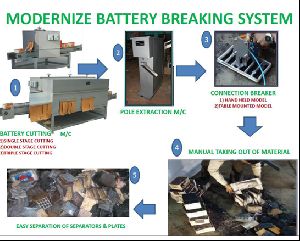
PROCESS FOR BATTERY CUTTING SYSTEM
Step 1: Place Battery On Conveyor, On Battery Cutting M/C.Step 2: Extract Poles On Pole Extraction M/C.Step 3: Break Connection Joints By Connection Breaker.Step 4: Manually Take Out The Battery Material.Step 5: Separators & Plates Can Be Easily Separated
...more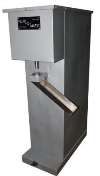
Pole Extraction Machine
Once Lid is cut from battery, there is Lead casted Pole/Post molded in Lid. This Pole can be extracted from Lid. Pole Extraction Machine will be used for this purpose.This machine is fitted with interchangeable die. This die can changed by pick & place technique. This machine is pneumatically operated and initiated by Pedal Valve. Cut Lid is placed on die and machine is operated by pressing foot on valve. Top punch presses Pole out of Lid. This can be seen in the video. Now, Lid will be with-out Lead parts. Of course, Lead parts will be having bit of Plastic in which it is molded. This Plastic can be ignored.
...more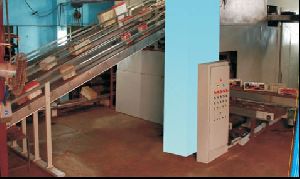
Plastic Crushing Machine
The shaved lid which is separated from under the welded straps is sent through conveyor to Lid Crusher Machine. Plastic parts are separated from the Lead parts. Such plastic parts are sent to the Plastic Crusher & are cut into smaller pieces. This machine is used to crush Battery Container made of Plastic Material. It crushes to small Pieces up to size of 1" square in one go and Washes Lead accumulated on it. It is shearing & hammering action increases its Power versus Output Ratio. Lead is precipitate on another conveyor. This conveyor conveys Lead Particles/ Pieces to one side. Plastic which can float on water will be filtered on another Conveyor. Plastic is fed to Plastic Washing Machine. This Plastic Washing Machine washes Plastic with Soap Solution. Plastic is filtered and collected. Water is used again after purification. Total Power: 56 H.P./42Kw. Container Feeding Conveyor: This conveyor is used for feeding Plastic Container to Plastic Crusher: M.S. material makes. The Drive of Electrical, 415V/380V, 3 Phases, 50Hz, 0.5 HP Crushed Plastic Feeding Conveyor: This conveyor is used for feeding crushed plastic to Plastic/ Lead Separation Machine; It is of MS material.
...more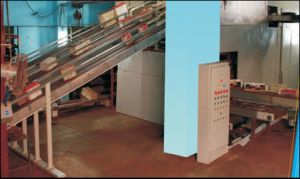
PARTS SEPARATION MACHINE
The Lid part is completely crushed and sent to Lead-Plastic separating Machine: i.e., Metal Classifier; with this process plastic parts are separated from the Lead parts. Such plastic parts are sent to the Plastic Crusher & are cut into smaller pieces. The Rest of the battery is moved on conveyor to the PART SEPARATOR MACHINE & all the parts are separated totally and sent to their separate respective storage tanks with the help of Conveyor systems. This separation machine is enclosed & no dust particles come out of the plant this increases plants recovery & reduces wastages of material. For dust collection BAG HOUSE is attached so that the oxide dust is stored in a filter bag. In this machine, on the First stage, the Battery Casings are taken out & sent to their separate section through its connecting conveyor. Later on, these Casings are sent to the same earlier Plastic Crusher, or a separate crusher can be placed as per customer's choice at additional cost which depends upon the Production capacity of the plant.After this step, the Plates & Separators are sent to the second level, in this section using a particular stage of vibration resonance at certain level we have taken out maximum quantity of Lead parts from the Plates & Shredded oxide material on the Third stage for Collection in its particular storage tank. In this stage, we took out the impregnated material from the plates on Grid. The rest material on plates are taken out with Battery Separators are sent to the Part Separation Machine on which the Plates are separated on one stage i.e., on one side & Separators are stored on other side. The Plate Parts & Separator Parts are separated and here we are collecting the rest of the shredded oxide material. The Grid parts & separators are separated by using the Grid-Separator Separation Machine. In this machine, Both Grids parts & separator parts are dropped through conveyor. Heavy air & water pressure is given simultaneously in the machine and by using floatation method we are separating the Separators & Grid Parts. These shredded Plates are sent to the FURNACE FOR SMELTING [Recycling]. And the Separators are sent through conveyors to A Separator Washing Machine. This separator washing machine is added to the system as per the customer's on demand or as per the plant production capacity. The machine is completely enclosed and environment friendly. Getting back on Parts Separation Machine, in the third layer of separation, Broken Separator Parts, Broken Grid Parts & Oxide Dust is taken out & sent to the other Metal Classifier & Floatation Tank is attached on that. In this section, Separator parts floats in water tank. The Lead Parts & the Oxide dust is settled down on the bottom side of the tank due to its weight & taken out with the help of rotary valve. And, the same water can be used again & again. The transferring of Lead Parts & Oxide Dust material can be sent to their respective Refining Pots & Smelting Units through Fork Lifts/ automatically with the help of automated mechanized system that will be on customer's demand at additional cost.
...more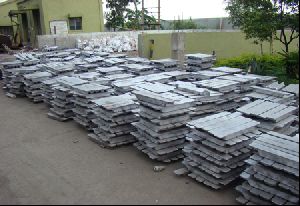
Lead Scrap
Like copper, lead has also been a familiar metal used by human beings since ancient times. Lead, a highly malleable and easy to melt metal, is widely used in various industries even today. However, due to its highly toxic nature, the use of lead has been facing pressure from environmentalists in recent years. The pressure to end manufacture of lead-based paints is an example of the growing concern on the potential health hazards caused by lead. Plastics, aluminum, tin, and iron are replacing the use of lead in construction materials, containers, packaging, etc. Tin and other metals are being used to replace lead as a solder in some applications where lead could poison people, such as in drinking water systems. Lead is a very corrosion-resistant, dense, ductile, and malleable blue-gray metal that has been used for at least 5,000 years. Early uses of lead included building materials, pigments for glazing ceramics, and pipes for transporting water. The castles and cathedrals of Europe contain considerable quantities of lead in decorative fixtures, roofs, pipes, and windows. Prior to the early 1900's, uses of lead in the United States were primarily for ammunition, brass, burial vault liners, ceramic glazes, leaded glass and crystal, paints or other protective coatings, pewter, and water lines and pipes. The advent of the electrical age and communications, which were accelerated by technological developments in World War I, resulted in the addition of bearing metals, cable covering, caulking lead, solders, and type metal to the list of lead uses. With the growth in production of public and private motorized vehicles and the associated use of starting-lighting-ignition (SLI) lead-acid storage batteries and terne metal for gas tanks after World War I, demand for lead increased.Most of these uses for lead continued to increase with the growth in population and the national economy. Contributing to the increase in demand for lead was the use of lead as radiation shielding in medical analysis and video display equipment and as an additive in gasoline. By the mid-1980's, a significant shift in lead end-use patterns had taken place. Much of this shift was a result of the U.S. lead consumers compliance with environmental regulations that significantly reduced or eliminated the use of lead in nonbattery products, including gasoline, paints, solders, and water systems. More recently, as the use of lead in non-battery products has continued to decline, the demand for lead in SLI-type batteries has continued to grow. In addition, the demand for lead in non-SLI battery applications also has continued to grow. Lead is processed & refined from lead scrap batteries. Non-SLI battery applications include motive sources of power for industrial forklifts, airport ground equipment, mining equipment, and a variety of nonroad utility vehicles, as well as stationary sources of power in uninterruptible electric power systems for hospitals, computer and telecommunications networks, and load-leveling equipment for electric utility companies. By the early 2000's, the total demand for lead in all types of lead-acid storage batteries represented 88% of apparent U.S. lead consumption. Other significant uses included ammunition (3%), oxides in glass and ceramics (3%), casting metals (2%), and sheet lead (1%). The remainder was consumed in solders, bearing metals, brass and bronze billets, covering for cable, caulking lead, and extruded products. Lead is mined in the United States, Canada, Mexico, Australia, and Peru. More than 1 million tons of lead is recovered in recycling annually, the majority of which is from the recycling of batteries. Australia and China are the leading suppliers of lead in the world. China, India, Japan, US and European Union are the main consumers of lead in the world. Lead is traded mostly as soft lead, animated lead, lead alloys and copper-based lead scrap. India imports nearly 50 percent of its lead requirement every year. Lead production in India is estimated to be around 82,000 ton, mostly from secondary sources. Lack of any major lead ore deposit is the main constraint for enhancing domestic lead production. The domestic industry is characterized by the presence of only a few players in the primary segment. The primary lead industry in India is divided between the following main players: Binani Industries Limited and Sterlite Industries (India) Ltd. (Hndustan Zinc Ltd.). Due to increasing use of lead in domestic market both players are expanding their smelting capacities for lead. Lead in the global market is traded as soft lead, animated lead, lead alloys and copper-base scrap.
...more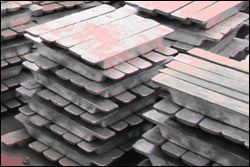
JUMBO INGOT MOULD
Jumbo Ingot Moulds are collection trolleys used for collecting molten lead from Rotary Furnaces. They can be of varyingcapacities, ranging from 300 Kg. to 800 Kg. The most prevalent of the same is 500 Kg. Ingot Mould. Due to higher weight of thecast, it is called a These moulds have trolley type structure with two unidirectional wheels at the back and one free spin wheel at the front. It isprovided with a handle to pull it. They are moved manually or on rails electro-mechanically, varying from unit to unit. They aresmoothened on the inside and do not have any sharp folds or edges. They are usually constructed in SG cast iron for longer life and increased strength.
...more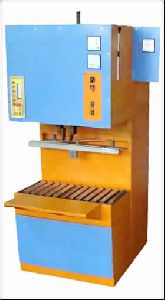
Inter Partition Welding Machine
Application :- This machine connects cells through the partition of container.Operation :- This Machine forges L- connecter of cells through the hole of partition together and passes heavy current at low voltage so portion of these connecter through hole of partition melts, taking advantage of resistance of lead, and become single entity. This machine does mass production and running cost comes to minimum, hence cost per battery is reduced to minimum. Transformer :- Current source of Machine is state of art heavy transformer of 65 KVA rating. We use best quality of copper, which dissipates lesser heat. So machine does not waste Costly electricity in the form of heat. Only Air-cooling is sufficient. If water-cooling is used it will increase running load of pump and wastewater, which has also becoming precious and harming the environment so our machine is environment friendly. At the same time reducing running cost of machine. Welding Computer (Micro Processor based Controller) :- It is designed indigenously as per need of our operator. This computer supply constant energy at constant current. Welding processes & parameters are controlled automatically & accurately by specially designed microprocessor. Operator can program 10 programs for different batteries. All parameters such as Squeeze Time, Weld Time, Cooling Time and required Current as per battery size, are fed to controller for battery size and recall whenever that size of battery is made. Operator can also see which operating time has been lapsed which other controllers do not provide. He can also communicate if any of the problems so he could be guided directly without physically present on the machine. If any type of problem arises it can be replaced/ repaired at nominal cost even after warrantee period.Welding Heat adjustment :- This controller is specially designed to suite lead melting say 250ºC to 700ºC, this bend is divided in 99 digits setting, unlike imported Controllers i.e. Miyachi etc which has controlling temperature from 50ºC to 3000ºC this bend is also divided in 99 digits setting, so operator does not get accurate results. This results in faulty connection without consistency. Welding Heat Adjustment: 0 to 99%, Welding Time Adjustment: 0 to 99, All are digital Display.Double Arms Movement :- For forging, we have designed better Forging Head. This head has double arms movement and self-centering arms.
...more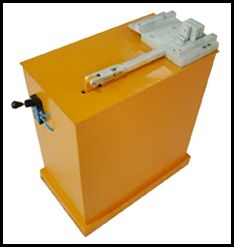
Hole Punching Machine
Application :- This machine punches Single hole at a time in partition of container. Machine is pneumatically powered. Different size of hole can be done with the help of different die for different size of batteries. Three Dies will make five sizes of batteries.Operation :- Place the container in upside down position to fit required slot. To punch five holes, five operations are required to be repeated. Different die is required to suit different size of battery container.
Capacity : 40 containers/ hour.
...more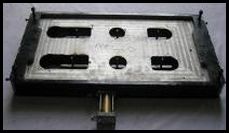
Heat Sealing Fixtures
Application :- This will check strength of welded connections torsion strength by applying mechanical force across connections. Operation :- Fingers has to put manually across connection so it is able to apply Force on one connection against other this force can be varied depending on connection size or size of battery, if that connection is hollow it will break. The time to apply force is determined by Digital Timer so force as well time to apply force is precisely preset hence result become accurate.
...more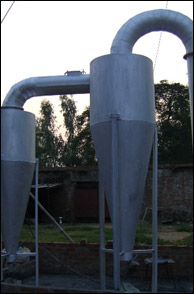
Gravity Chamber
Cyclone is used to remove medium size particles from flue gases stream. The treated flue gases are discharged from topand dust is collected at bottom. Difficult to produce low Antimony lead suitable for soft lead purposes. Fugitive Emissions need to be captured in addition to flue gases. Need skilled operators and careful maintenance.
...more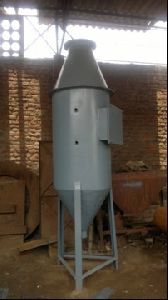
Air Pollution Control Wet Scrubber
A Wet Scrubber in the Air Pollution Control System is mandatory in India and many parts of the world. Wet Scrubber uses water to scrub clean the flue gases of any pollutant gases or particles that may remain after Bag Filtration System. The Scrubber therefore requires a pump, pipeline and a retention tank.The size of the Scrubber depends upon the capacity of the system being installed. Flue gases are introduced in the body of theScrubber from side and as they move up towards the top of the Scrubber which has the outlet, they pass through a spray of fine water droplets provided by a spray shower provided in the body. This fine spray leads to scrubbing of any pollutant in the flue gases. Cleaned gases escape through the top opening after passing through a mist eliminator whereas water with pollutants moves to the bottom of the Scrubber from where it is passed into the tank. One or more chambers of the tank allow for settling of pollutants which are then periodically cleaned and fresh water is added to make up any loss in quantity of water.It is then recalculated to the Scrubber.
...more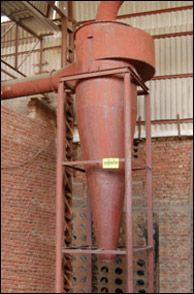
FUGITIVE EMISSIONS CONTROL DEVICE
Smelting of lead in furnaces involve stages or parts where though pollution is generated, it is not handled by the main AirPollution Control System, like charging of Rotary Furnace when it is red hot or tapping of lead from Rotary Furnace which leadto generation of fumes.Systems put in place to capture and treat these fugitive emissions as and when they arise are called Fugitive Emission ControlSystem. Fugitive Emissions generally lead to pollution of work atmosphere and jeopardize the maintenance of ambient airstandards at the workplace. Hence, to safeguard employee health, these systems are becoming mandatory world over.Norms of Ambient Air which the Fugitive Emissions Control System helps to meet are Parameter Approved Range Time Period PM (size < 2.5 micron) < 40 microgm/ Nm3 Annual Basis PM (size < 10 micron) < 60 microgm/ Nm3 Annual Basis Lead < 0.5 microgm/ Nm3 Annual Basis SO2 < 50 microgm/ Nm3 Annual Basis NO2 < 40 microgm/ Nm3 Annual Basis Allows large size particles to settle down Cools down temperature of flue gases Used as spark arrestor to entrap live or red hot particles.
...more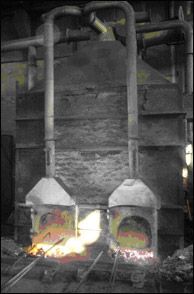
DOUBLE TEMPLE FURNACE
Lead to be manufactured from Mini Blast Furnace is usually obtained from scrapped batteries. They are cut open or broken to segregate lead scrap, plastic and other materials from it. Lead scrap in the form of lead powder and plates etc. is charged inthe furnace along with a proportionate charge of wooden coke. Thereafter the furnace is manually fired with the help of rags.FD Fan provides the necessary air required for combustion from the back of the furnace. Coke in the oven performs thefunctions of both, the fuel as well as a reducing agent for obtaining lead from its oxides charged in the form of lead plates & Powder.Temperature of the furnace is maintained at the desired level for approximately 30 minutes, after which molten lead along with slag flows out from the bottom of the oven into the outlet pit. Here slag is separated and molten lead is poured into IngotMoulds. To maintain this, continuous charge of raw material and coke is maintained in the furnace.This process leads to generation of flue gases which are toxic in nature and need appropriate and adequate Air PollutionControl System for their treatment.
...moreBe first to Rate
Rate ThisOpening Hours